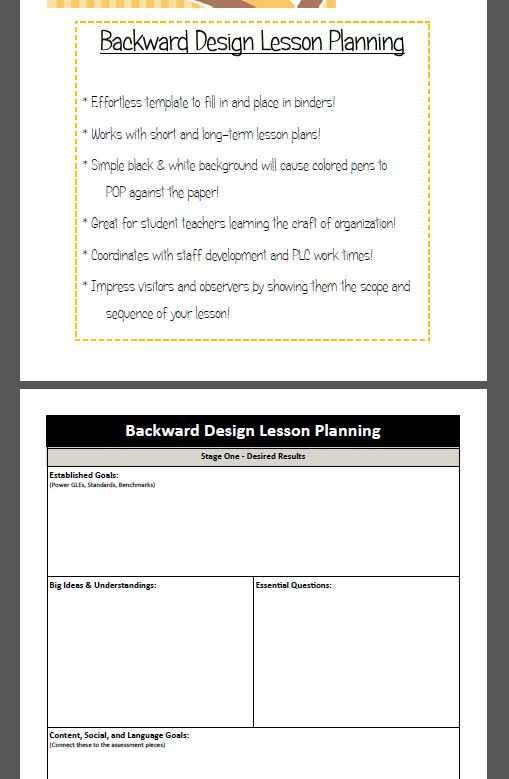Table Of Content

For now, though, I’m just going to share the most basic version of backward design. Notice that in this approach, the assessment is created after the lessons are planned. Sometimes it isn’t created until most of those lessons have already taken place. The assessment is kind of an afterthought, a check to see if students were paying attention to the stuff we taught them. I mean, even though I loved the book, my students’ response to it was mostly lukewarm.
Stage 1: Identify Desired Results
Now, before you go crazy planning all new lessons, I suggest taking inventory of the activities and lessons you already have mapped out. Chances are, you can find a place for many of them in your new instructional plan. However, now you’ll feel more confident in a clear connection between the lesson and the overall learning objective. Some lessons might need a slight tweak here or there and others might be best to leave out altogether.
QUESTIONS TO ASK BEFORE SELECTING A CURRICULUM DESIGN COURSE
If you have learning goals that are closely related, you may have learning outcomes that correspond to more than one goal in your course. This common approach to course design looks reasonable at first glance, but it also presents some challenges. As experts in their fields, instructors are not always the best judges of what their more novice students might find engaging. And while some disciplinary traditions exist for good reason, others may have developed by chance or worked better for previous generations than today’s learners. Finally, recycling the assignments from a former course may not always be the best fit for a new course.
Alignment of learning objectives to feedback and assessment
Unlike Backward Design, which is highly structured around pre-set objectives and assessments, Montessori is far more exploratory and driven by the student's own interests. So whether you're in a classroom filled with children, a university lecture hall, or a corporate training room, Backward Design offers a structured and effective way to reach your learning goals. This approach is flexible enough to be customized for any educational context. When students are aware of the learning objectives from the start, as they are in a Backward Design framework, they are likely to be more motivated to achieve those objectives. Knowing what the end goal is, just like knowing what the treasure is at the end of a hunt, can make the educational journey more motivating and fulfilling. Once you figure out your student-focused learning goals, you’ll be better equipped to figure out how best to test for those goals instead of the other way around.
Developing a backward design lesson plan step by step
These overarching goals guide the entire instructional process, ensuring that students focus on essential concepts rather than getting lost in minutiae. By starting with these big ideas, teachers can develop learning experiences that lead to deeper understanding and mastery of important concepts. Backward design in education is a lesson planning strategy that starts with the final assessment, then asks teachers to build their lessons toward that goal. This differs from transitional lesson design, in which teachers identify content they need to cover, build relevant lessons, then create the final assessment. Backward lesson design encourages teachers to be more intentional about their lesson plans and ensures that they make the best use of class time.
Instruction
In the past, classroom instruction has focused on the instructor and the ways in which the subject matter could best be presented to the student. Wiggins and McTighe propose a framework called Six Facets of Understanding as a guide for building effective assessments. It is made up of six non-hierarchical ‘domains’ or ‘facets’ that they identify as indicators of understanding.
When designing lessons, ensure your instructional strategies and course design both emphasize the knowledge and skills your students need to achieve the learning goals you set/identified earlier. But in other cases, it might be wiser to use backward design lesson plans. The right backward design lesson plan may result in a better learning experience for a classroom full of students, a private client, and everyone in between.
Choosing The Right Assessments For Your Students
Backward design encourages educators to move away from traditional methods of design, such as direct instruction or lecture-based formats, and instead embrace a more integrated approach. By prioritizing the desired learning outcomes and considering students’ progress throughout the entire course, instructors can create a more cohesive and effective learning experience. Backward design offers a much more intentional approach to curriculum development compared to traditional methods. By starting with the end goal in mind, educators can ensure that every component of the curriculum is aligned with desired learning outcomes. This integrated approach fosters coherence and relevance in the learning experience, ultimately leading to improved student success. Backward design lesson planning is a practical and effective approach to curriculum development and instructional design.
Backward Design Step 3. Plan a Sequence of Lessons
This approach to curriculum development starts with the desired learning outcomes before moving backward to plan instruction and learning activities. In contrast, the backward design approach has instructors consider the learning goals of the course first. These learning goals embody the knowledge and skills instructors want their students to have learned when they leave the course.

What if lesson planning was rooted in specific learning goals and skills rather than general topics? And what if assessments were designed before the daily lessons and activities? Another benefit of backward design is that it allows for more flexibility and adaptability in teaching.
It will begin with writing a clear content objective, then move onto creating an effective assessment that measures student mastery of the content objective, and finish with choosing appropriate instructional activities. In the realm of education, there exists a multitude of methods for crafting curriculum and designing courses, each with its own merits and applications. However, few approaches rival the depth and efficacy of backward design, a framework developed by Jay McTighe and Grant Wiggins. This innovative methodology has revolutionized the way educators conceptualize and implement their teaching strategies, placing a profound emphasis on desired results and student learning outcomes. Let’s delve into the intricacies of backward design, exploring its stages, principles, and applications in various educational settings. Backward design lesson planning is an approach to curriculum development that starts with the end goal in mind.
Now once we’ve done those two steps, lets compare them side by side to see if they match the content that we are bringing in. If you feel that the content in the chapter doesn’t reflect the outcomes, then cut it out and put it in a separate document so that you have it later on. Backwards design is simply starting from the outcome (or transformation) for your students & building the modules/chapters/sections with those outcomes in mind. “Aligning teaching for constructive learning.” Higher Education Academy Discussion Paper. By creating 3 columns of goals I simply choose at least one from each for any given lesson. That way I can see at a glance if everything is checked off in the first two columns.
Enhancing Japanese elementary and junior high-school foreign language education - Open Access Government
Enhancing Japanese elementary and junior high-school foreign language education.
Posted: Wed, 17 Jan 2024 08:00:00 GMT [source]
Instead of starting with what educators want to do, it starts with what students need to learn. This learner-centered focus makes it a powerful approach for modern education, where student engagement and outcomes are increasingly emphasized. In this model, traditional classroom activities and homework assignments are reversed. Teachers like Aaron Sams and Jonathan Bergmann have popularized this approach, which often involves students watching lectures at home and engaging in activities during class. While the Flipped Classroom also aims for active learning and engagement, it doesn’t necessarily start with specific outcomes in mind, making it different from Backward Design in its initial focus. Popularized by education reformers like John Dewey, Project-Based Learning focuses on complex questions or challenges that require students to engage in critical thinking, problem-solving, and collaboration.
Reflect upon the impacts of climate change on their local communities and in their everyday lives. Now that you’ve identified the outcomes and competencies for the course, repeat the process for the next modules/chapters in your course. Rinse and repeat and then go back to the beginning to review and have someone else to employ a fresh lens and perspective and check that its accurate.
If the teacher has explicitly defined the learning goals of the course, then they have a better idea of what they want the students to get out of learning activities. Furthermore, if done thoroughly, it eliminates the possibility of doing certain activities and tasks for the sake of doing them. Every task and piece of instruction has a purpose that fits in with the overarching goals and goals of the course.
The concept of Backward Design was invented by two education experts named Grant Wiggins and Jay McTighe in the late 1990s. Their goal was to make learning more focused and useful, not just for kids in school but also for adults in professional settings. You walk away really getting it, able to use what you learned in real life. Well, there's a good chance the person teaching you used Backward Design to plan that awesome learning experience. In no time at all, you might see improvements in the performance of your students, the quality of your classes, and the ratings of your online lessons. Check out this backward design lesson plan template from Vanderbilt University.

No comments:
Post a Comment